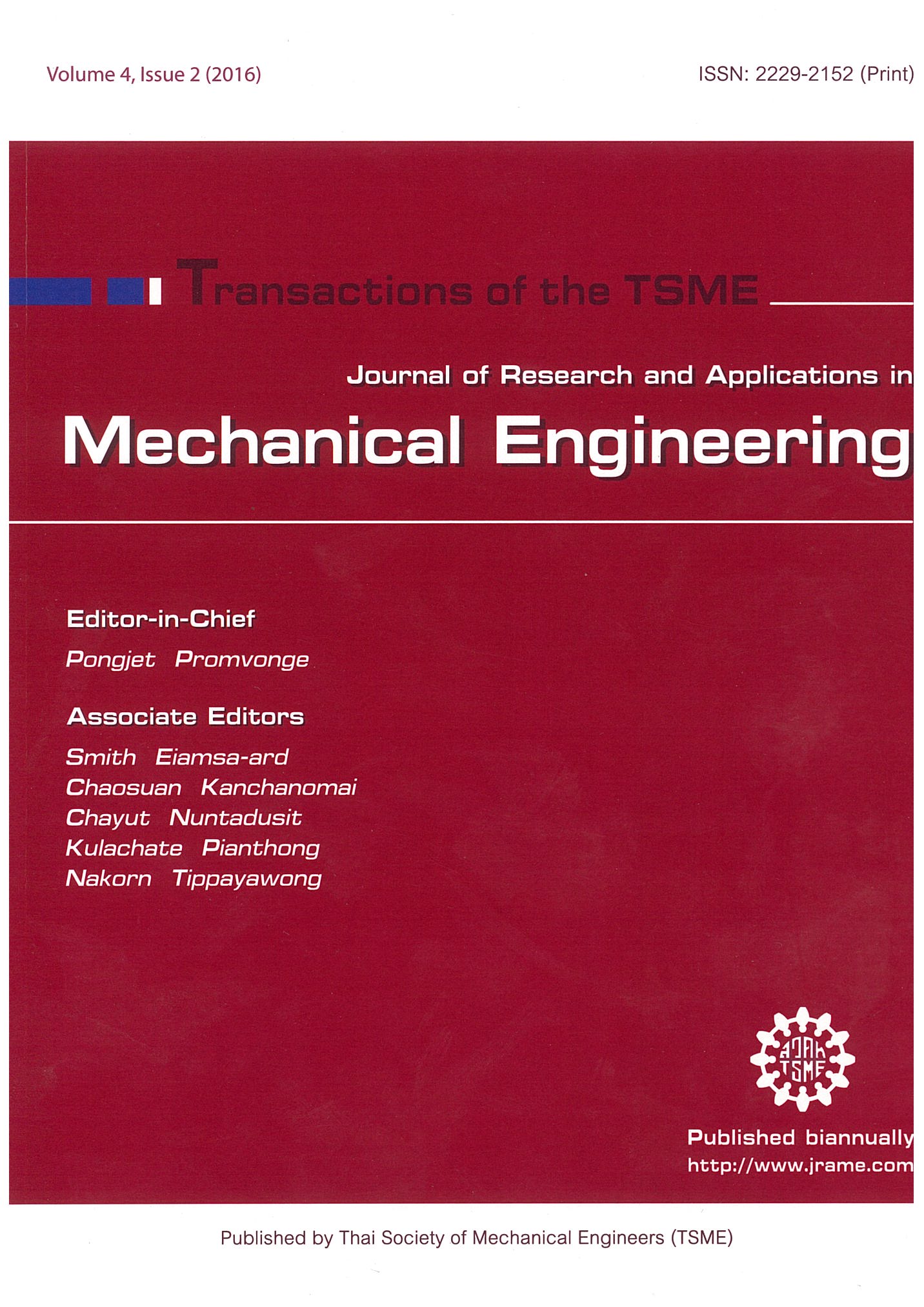Impact of soot on metal wear characteristics using laser diffraction spectroscopy
Main Article Content
Abstract
The characteristics of soot affecting on the abilities of lubricating oil and leading to result in metal wear was studied. Soot particle contamination was simulated using carbon black. Micro-nanostructure of particles were studied by electron microscope. The behavior was studied by means of a Four-Ball tribology test with friction and wear measured. Wear roughness in micro-scale was also investigated by high resolution optical microscope and 3D rendering optical technique. Based on tribology test, soot contamination in oil made more wear on tested steel ball and reduced friction during test comparing to the test with fresh oil. In conclusion, the appropriate particle size (20 nm - 80 nm of primary particles and 80 nm - 300 nm of agglomerated particles), which is near to oil film thickness between metal surface contacts, is the dominant cause of making wear. By the way, the too large particle size compared to oil film thickness will escape out and too small particle size will not effect on wear. Furthermore, high level of proper particle size (20 nm – 100 nm) contaminated in oil will increase probability of rubbing process.
Article Details
This work is licensed under a Creative Commons Attribution-NonCommercial-ShareAlike 4.0 International License.
References
[2] Ryason, P.R., Chan, I. and Gilmore, J.T. Polishing wear by soot, Wear, Vol. 137, 1990, pp. 15-24.
[3] Ratoi, M. and Spikes, H.A. The influence of soot and dispersant on ZDDP Film thickness and friction: Lubrication Science, Vol. 17, 2004, pp. 25-43.
[4] Aldajah, S., Ajayi, O.O., Fenske, G.R. and Golblatt, I.L. Effect of exhaust gas recirculation (EGR) contamination of diesel engine oil on wear, Wear, Vol. 263, 2007, pp. 93-98.
[5] Yamaguchi, E.S., Untermann, M., Roby, S.H., Ryson, P.R. and Yeh, S.W. Soot wear in diesel engines, Proceedings of the Institution of Mechanical Engineers, Vol. 220, 2006, pp. 463-469.
[6] George, S., Ball, S., Guatam, V. and Guatam, M. Effect of diesel soot on lubricant oil viscosity, Tribology International, Vol. 40, 2007, pp. 809-818.
[7] Esangbedo, C., Boehman, A.L. and Parez, J.M. Characteristics of diesel engine soot that lead to excessive oil thickening, Tribology International, Vol. 47, 2012, pp. 194-203.
[8] Guatam, M., Chitoor, K., Durbha, M. and Summers, J.C. Effect of diesel soot contaminated oil on engine wear – Investigation of novel oil formulations, Tribology International, Vol. 32, pp. 687-699.
[9] Aldajah, S., Ajayi, O.O., Fenske, G.R. and Golblatt, I.L. Effect of exhaust gas recirculation (EGR) contamination of diesel engine oil on wear, Wear, Vol. 263, 2007, pp. 93-98.
[10] Hu, E., Hu, X., Liu, T., Fang, L., Dearn, K.D. and Xu, H. The role of soot particles in the tribological behavior of engine lubricating oils, Wear, Vol. 304, 2013, pp. 152-161.
[11] Truhan, J.J., Qu, J. and Blau, P.J. The effect of lubricating oil condition on the friction and wear of piston ring and cylinder liner materials in a reciprocating bench test, Wear, Vol. 259, 2005, pp. 1048-1055.
[12] Soejima, M., Ejima, Y., Uemori, K. and Kawasaki M. Studies on friction and wear characteristics of cam and follower: influences of soot contamination in engine oil, JSAE Review, Vol. 23, 2002, pp. 113-119.
[13] Jao, T.C., Li, S., Yatsunami, K., Chen, S.J., Csontos, A.A. and Howe, J.M. Soot characterisation and diesel engine wear, Lubrication Science, Vol. 16-2, 2004, pp. 111-126.
[14] Karin, P., Oki, H., Hanamura, K. and Charoenphonphanich, C. Nanostructures and oxidation kinetics of diesel particulate matters, Transactions of the TSME, JRAME, Vol. 1-2, 2012, pp. 3−8.
[15] Karin, P., Borhanipour, M., Songsaengchan, Y., Laosuwan, S., Charoenphonphanich, C., Chollacoop, N. and Hanamura, K. Oxidation kinetics of small CI engine’s biodiesel particulate matter, International Journal of Automotive Technology, Vol. 16-2, 2015, pp. 211-219.
[16] Karin, P., Boonsakda, J., Siricholathum, K., Saenkhumvong, E., Charoenphonphanich, C. and Hanamura, K. Morphology and oxidation kinetics of CI engine’s biodiesel particulate matters on cordierite diesel particulate filters using TGA, International Journal of Automotive Technology, Vol. 18-1, 2017, pp. 31−40.



